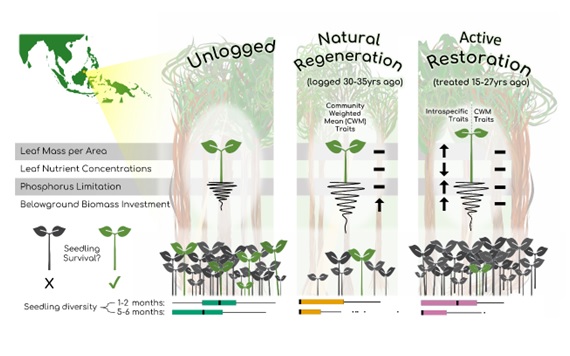Rainforest seedlings are more likely to survive in natural forests than in places where logging has happened – even if tree restoration projects have taken place, new research shows.
An international research team including the UK Centre for Ecology & Hydrology (UKCEH) studied a landscape in North Borneo containing both natural forest and areas logged 30 years ago. Some previously logged forests which were recovering naturally and some which had undergone restoration through a mixture of tree planting and removal of competitive plants such as climbers.
The scientists monitored over 5,000 seedlings for 18 months after a drought triggered ‘mast fruiting’ across the region, with trees simultaneously dropping fruit en masse and new seedlings emerging.
At first, both natural forest and restored forest had similarly high numbers of seedlings, compared to naturally recovering forest – suggesting restoration activities enhanced fruit production. But these benefits did not last.
Low seedling survival in the restored forest meant that, by the end of the study period, similarly low numbers of seedlings remained in restored and naturally recovering forest. Seedling populations remained higher in natural forest.
The research, published in the journal Global Change Biology, showed that highly specialised tree species, in particular, struggled to survive, leaving communities with reduced diversity compared to intact forests. While restoration has been shown to benefit the total amount of growth in these forests, the research indicates this is not yet enabling full establishment of the next generation of seedlings.

Dr Lindsay Banin of the UK Centre for Ecology & Hydrology, who was part of the research team, said: “Together, these results reveal there may be bottlenecks in recovery of particular elements of the plant community.
“We are now progressing this research into the various stages of the regeneration process – fruiting, germination, establishment and causes of mortality – to help understand which mechanisms are driving the patterns we have observed and how we can better assist forest regeneration and support the long-term sustainability of degraded forests.”
Plant characteristics (or traits) that determine how plants function may be the key to understanding the low survival rates of seedlings, for they can reveal which resources the plants are struggling to access.
Co-lead author David Bartholomew, of Botanic Gardens Conservation International, says changes to the canopy structure, microclimate and soil in logged forests could create adverse environmental conditions that reduce survival rates and functions of trees, and effects could vary between species. These impacts could affect the diversity and composition of these disturbed forests into the long term.
Another possible factor affecting spatial patterns in seed and seedling survival is interactions with local animal populations.
Animals that eat seeds – like bearded pigs – may be drawn into restored forest patches to eat the more abundant seeds and seedlings, creating high mortality in these areas, rather than moving into adjacent poor-quality logged forest. In natural forests, animals can move more freely and so do not exhaust seed supplies in the same way.
Selective logging of forests is prevalent throughout the tropics and recovery is essential for carbon sequestration, species diversity and providing food for animals.
The study therefore highlights the importance of carefully designing, monitoring and adaptively managing restoration projects, which would help meet the Kunming-Montreal Global Biodiversity Framework, which commits countries to halt and reverse nature loss by 2030 as well as increasing the abundance of native wild species to healthy, resilient levels by 2050.
Paper information
Bartholemew, Hayward et al. 2024. Bornean tropical forests recovering from logging at risk of regeneration failure. Global Change Biology. DOI: 10.1111/gcb.17209. Open access.
The study involved scientists from Exeter, Aberdeen and Stirling universities, UKCEH, ETH Zürich, the Forest Research Centre in Sepilok, Consejo Superior de Investigaciones Científicas in Spain and the SE Asia Rainforest Research Partnership in Malaysia.